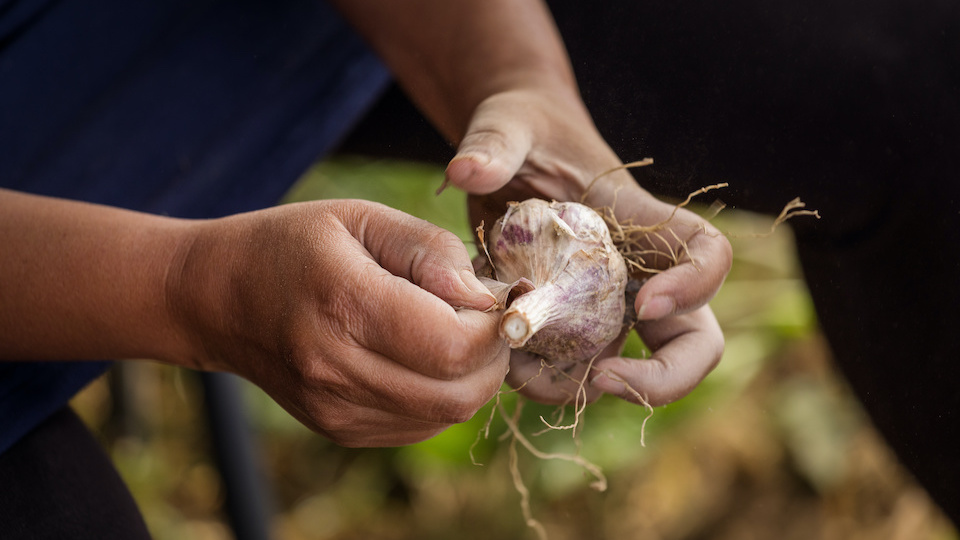Many people hesitate to grow garlic because it requires a different strategy from most plants in your vegetable garden. Once you know how to do it, though, growing garlic is easy and well worth it. Fresh garlic from the garden tastes much better than store-bought garlic, which has been in storage for ages. An added benefit? Garlic is a potent superfood that boosts health in several ways.
Why Grow Garlic? The Proven Health Benefits of Garlic
Garlic is so much more than an important aromatic in your favorite recipes. It is also a potent health food. People have known about the health benefits of garlic since ancient times, but modern researchers have put it to the test:
- Garlic can help prevent the common cold and flu. In one study, participants received a garlic supplement for 12 weeks. Compared to the control group, they were much less likely to get a cold, and when they did, they recovered more quickly. Another study found garlic extract could reduce sick days by 61% and reduced the severity of symptoms.
- Garlic lowers blood pressure. Studies show that garlic supplements reduce blood pressure in people with hypertension. One study even showed that a garlic extract effectively lowered blood pressure as a prescribed mediation, Atenolol.
- Garlic improves cholesterol profile. Garlic supplements have been proven in studies to reduce LDL cholesterol (the so-called bad cholesterol) by up to 15%. This, in turn, may help reduce the risk of heart disease.
- Antioxidants in garlic may reduce dementia risks. The above benefits have been proven multiple times over, but other ways it can improve health still under investigation. Garlic contains antioxidants, and studies show that high-dose supplements increase antioxidant enzymes in the body and brain. This could reduce the risk of Alzheimer’s disease and dementia.
- Garlic may detoxify the body. A study of workers in a car battery plant found that garlic supplementation helped reduce lead levels in the blood. The reductions were as much as 19%, but the participants also showed fewer toxicity signs, like headaches and high blood pressure.
When to Plant Garlic
When growing garlic, the first thing to understand is the timing. Unlike many vegetables, you begin in late winter and early spring, garlic goes in the ground fall through spring, depending on the climate. Late autumn is an excellent general guideline. The roots develop through the winter, greens grow in spring, and bulbs are ready to harvest in summer.
In warmer climates, you can get away with planting garlic in early spring. If you plant in fall, though, you will get bigger heads. The colder your climate is, the earlier in fall you can plant, as early as September.
Where to Plant Garlic
Next, choose your planting site according to garlic’s needs. Garlic prefers well-drained soil that is neutral to slightly acidic. Add organic compost or fertilizer if the soil is sandy or poor. Garlic does best in rich, fertile soil. If the soil is too heavy, turn it over with compost. You can also use raised beds if the soil is heavy. The site you select should get good sun.
Planting Garlic
Now you’re ready to plant garlic and grow big, tasty bulbs. For your first time growing garlic, get cloves from a nursery or seed company. Grocery store cloves don’t work as well. They may not be right for your region and may have preservative treatments on them that make growth slow and inadequate. You can also get cloves from a neighbor or friend who grows their own.
Pick large, healthy cloves to plant. Pull them apart from the bulb a few days before planting. Keep the paper on each clove. When you’re ready to put them in the ground, space them about two to four inches and upright. This means the root, or flat side should be pointing down and the tip-up. Space rows of garlic 10 to 14 inches.
Caring for Garlic Plants
In northern climates, add a layer of mulch over fall-planted cloves. Remove the mulch in the spring as the temperature warms and the threat of frost is gone. As flowers appear on your garlic plants, remove them. This focuses energy on large bulb growth. Those flower shoots, known as scapes, are edible. They have a milder garlic flavor. Eat them raw or cooked.
Give garlic plants a side dressing of nitrogen fertilizer in early spring and again in late spring as the bulbs begin to grow. If the leaves turn yellow in spring or early summer, add more fertilizer—weed throughout the growing season. Garlic doesn’t like the competition. Water the bulbs every few days from late spring through mid-summer. At this point, taper off the water.
Harvesting and Storing Garlic
Depending on when you plant the cloves, bulbs will be ready between late June and August. The right time to harvest is when the greens yellow and fall over but before they dry totally. Pull one bulb up first to test readiness. The bulb should be big with prominent cloves and the paper dry. Leaving them too long leads to split bulbs and potential disease.
Dig out bulbs rather than pulling. Keep them in a shady, dry spot with good airflow for a couple of weeks to cure. When everything is dry, and the root crown is hard, your bulbs are ready for storage. Keep them in a dark, cool, and dry place for months. The longer you store them, up to a point, of course, the better the cloves will taste. Don’t forget to save a couple of your best bulbs for next planting.
Planting and growing garlic correctly requires a few tips and tricks, but it’s an easy process once you understand them. This is a generally low-maintenance plant to grow, so don’t be afraid to try. You’ll enjoy it in the kitchen next year and reap the health benefits.
-Mary Ellis




